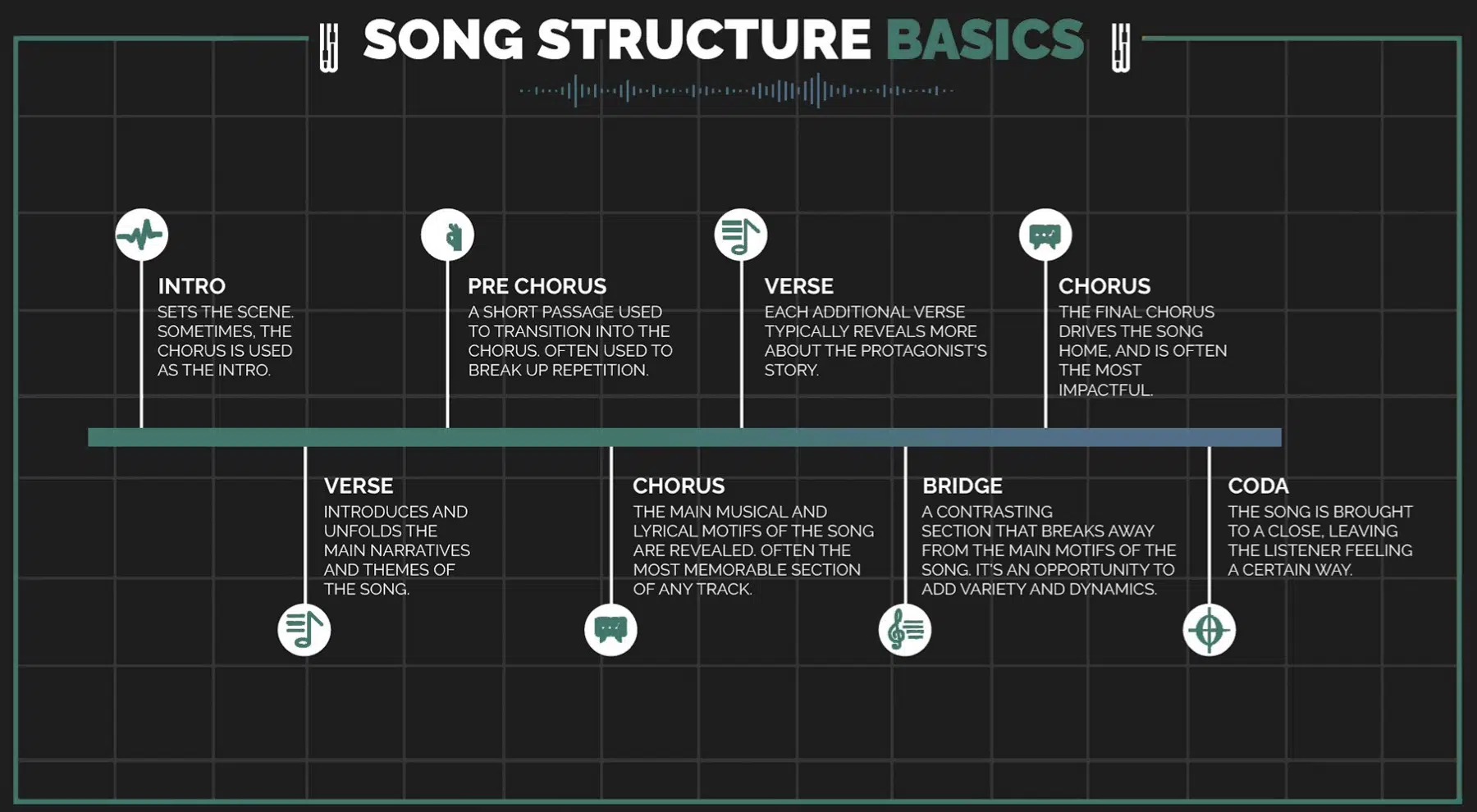What is Song Arrangement?
Definition and Importance
Song arrangement is the process of organizing and structuring the different sections of a song to create a flowing, dynamic, and cohesive composition. It involves deciding how various elements—such as verses, choruses, and bridges—fit together to tell the song’s story. Arrangement is essential for ensuring that the song holds the listener’s attention, builds emotional tension, and creates a memorable listening experience.
The Role of the Arranger
An arranger plays a key role in shaping a song’s structure. While the composer or songwriter may have a basic melody or idea, the arranger decides how the song will evolve over time, determining how instruments are layered, when different sections of the song are introduced, and how the song should build or release tension. An arranger ensures the song’s structure enhances its emotional impact and maximizes its appeal.
The Elements of Song Arrangement
Intro
The intro is the opening section of a song. It sets the tone and grabs the listener’s attention, offering a preview of what’s to come. Intros can be instrumental, vocal, or a combination of both, and they usually establish the song’s rhythm, melody, and mood.
Verse
Verses are the storytelling sections of the song. They often introduce new lyrics and melodies, gradually building upon the song’s central theme. Verses are typically less intense than the chorus and can vary slightly in melody and structure as the song progresses.
Chorus
The chorus is the emotional core of a song. It usually contains the song’s most memorable lyrics and melody, often delivering the main message of the song. Choruses are often the most powerful part of a song and are typically repeated throughout the track to reinforce the theme.
Bridge
A bridge is a contrasting section that provides a break from the repetitive verse and chorus structure. It can introduce a new melody, key change, or rhythm, adding variety and keeping the song from feeling monotonous. The bridge helps to build anticipation before returning to the final chorus.
Outro
The outro is the closing section of the song. It provides a sense of resolution and often mirrors elements from the intro or previous sections. Outros can fade out, end abruptly, or provide a final, conclusive statement that wraps up the song.
Different Song Arrangement Styles
Traditional Verse-Chorus Structure
The most common Discover more at cast-a-blast.com structure, especially in pop and rock, is the verse-chorus format. The song alternates between verses and choruses, with the chorus usually being the most repeated and emphasized section. This structure is easy for listeners to follow and helps to create a sense of familiarity.
A-B-A-C-A Format
The A-B-A-C-A format is another common structure. In this format, the song alternates between two main sections, “A” (which could be a verse or a chorus) and “B” (usually a bridge or instrumental section). This structure adds variation and intrigue while keeping a recognizable pattern.
The Role of Dynamics in Song Arrangement
Building Tension and Release
Dynamics are crucial to a song’s emotional journey. By carefully arranging the intensity of each section, the arranger can create tension that is later released in the chorus or bridge. For example, a song might start quietly, building in intensity toward the chorus, where the full instrumentation and louder dynamics deliver the emotional peak.
Using Instrumentation and Texture
The arrangement of instruments and their texture (thick or thin layers of sound) plays a significant role in shaping a song’s dynamics. A sparse arrangement with few instruments can create a sense of intimacy, while a full, layered arrangement can evoke a grand or powerful feeling. The careful balance of these textures can make a song feel more dynamic and engaging.
How to Arrange a Song: Step-by-Step
Step 1: Understand the Song’s Core Idea
Before diving into the arrangement process, it’s essential to understand the heart of the song. What is the central emotion or message? What are the main elements—the melody, rhythm, or lyrics—that define the song? Understanding this will help guide the arrangement process.
Step 2: Experiment with Structure
Once you understand the core idea, it’s time to play around with different structural possibilities. Try different combinations of verses, choruses, and bridges. See what feels natural and enhances the emotional impact of the song.
Step 3: Develop Transitions and Flow
Transitions between sections are vital for maintaining the song’s flow. You don’t want the changes between verses, choruses, and bridges to feel jarring. Use transitional elements, such as instrumental breaks or gradual changes in dynamics, to smooth the flow.
Step 4: Finalize Instrumentation and Arrangement
Once the basic structure is set, begin to finalize the instrumentation for each section. Choose which instruments will play during each part of the song and consider how they will contribute to the overall sound. This is the time to decide on key changes, harmonies, and the overall sonic landscape.
Common Mistakes in Song Arrangement
Overcomplicating the Structure
It’s easy to get carried away with adding too many sections or complex arrangements, but sometimes simplicity is key. Overcomplicating the structure can make the song feel cluttered and confusing. Stick to a structure that enhances the song’s message without overwhelming the listener.
Ignoring the Emotional Journey
A song arrangement should take the listener on an emotional journey. Failing to consider how the dynamics and transitions will affect the song’s emotional impact can result in a flat or disengaging arrangement. Always keep the emotional core of the song in mind.
Song Arrangement Tools and Techniques
DAWs (Digital Audio Workstations)
DAWs are essential tools for song arrangers. They allow you to experiment with different arrangements, layer instruments, and adjust the structure of your song in real-time. Popular DAWs include Ableton Live, Logic Pro, and Pro Tools.
Notation Software
For those working with sheet music or traditional arrangements, notation software like Finale or Sibelius is invaluable. These tools allow you to transcribe your arrangement and make detailed notations, helping to communicate your vision clearly.
The Future of Song Arrangement
Technology’s Impact on Song Structure
With advances in music technology, arrangers now have access to an array of tools that make the arrangement process faster and more creative. AI-powered tools and virtual instruments are pushing the boundaries of what can be achieved in a song arrangement.
Collaboration and Remote Arranging
The rise of digital platforms has made collaboration easier than ever. Songwriters and arrangers can now work with other musicians from around the world, exchanging ideas and creating arrangements remotely.
Conclusion
Song arrangement is an essential part of creating a memorable and impactful song. Whether you’re crafting a catchy pop tune or an emotional ballad, the structure of your song will play a huge role in how it connects with listeners. By understanding the elements of arrangement, experimenting with different styles, and using the right tools, you can elevate your music to new heights.


